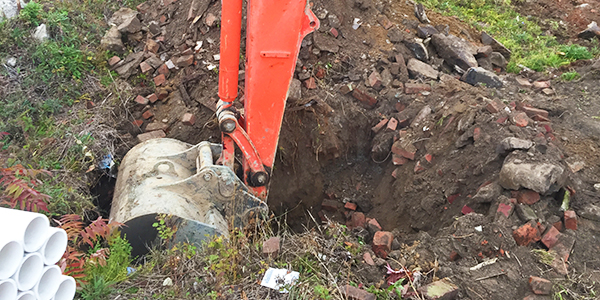
10 Jul What Lies Beneath: The Impact of Historic Fill
What is Historic Fill?
For decades, historic fill material was commonly used to raise the topographic elevation of properties around the state of New Jersey — predominantly along the waterfront areas in northeastern and southwestern NJ. The fill material, according to the New Jersey Department of Environmental Protection (NJDEP), is composed of “non-indigenous material… which was contaminated prior to emplacement, and is in no way connected with the operations at the location of emplacement and which includes, without limitation, construction debris, dredge spoils, incinerator residue, demolition debris, fly ash, or non-hazardous solid waste.” Because of the nature of its composition, historic fill material is a widespread concern for many property owners and potential property purchasers around the state. The NJDEP considers historic fill material an area of concern per the Technical Requirements for Site Remediation (TRSR).
The NJDEP and the New Jersey Geological Survey (NJGS) have mapped regions of the state where large areas of historic fill are believed to exist. If your property or the property you intend to purchase is located within these mapped areas, you need to determine if the property is impacted by historic fill. Typically, this is done through testing of soil samples taken from the property. If historic fill material is encountered at the property, the issue needs to be addressed.
Mitigating the Impact
There are several ways to address historic fill. Ultimately, the intended use of the property and the cost of remediation drive this decision.
The first and most common remedial strategy involves the use of engineering controls. Per the NJDEP, an Engineering control means “any physical mechanism to contain or stabilize contamination or ensure the effectiveness of a remedial action. An engineering control may include, without limitation, a cap, cover, building, dike, trench, leachate collection system, fence, physical access control, and groundwater containment system including, without limitation, a slurry wall and a ground water pumping system.” Two of the more common forms of engineering controls are the slab of a building and parking lots. Engineering controls require, at a minimum, annual inspections, potential maintenance, biennial recertification by an environmental consultant, and a permanent note on the deed, known as a Deed Notice. A Deed Notice is added to the title of a property when contamination remains above NJDEP’s residential/unrestricted soil remediation standards. This notification is permanent and can only be removed if the concentration(s) of the impacts fall below NJDEP’s residential/unrestricted soil remediation standards. The Deed Notice tells all potential purchasers that the property is impacted, which can have a negative effect on the property’s value. For this reason, some property owners prefer to avoid engineering controls and/or Deed Notices.[1]
Alternative Options
Engineering controls and Deed Notices can be obviated if the responsible party (RP) chooses to remediate the site. One important advantage to doing so is to gain full, unrestricted use of the property. Moreover, doing so means your deed remains unencumbered, thus helping to preserve the full value of the property.
One option for actively remediating historic fill is to excavate. The RP can remove soil either to the extent of the fill material or to the property boundary, whichever is encountered first. The excavated soil is then replaced with certified clean backfill. While feasible, this is not typically done for several reasons. It can be expensive and highly disruptive to a site, and buildings often impede the ability to reach all the impacted material. In addition, the volume of soil that needs to be excavated can often exceed the value of the property itself. Even so, the feasibility of remediation should always be considered.
Fortunately, the NJDEP allows compliance averaging techniques that may obviate the need for engineering or institutional controls or greatly reduce the volume of soil requiring excavation. For example, ESA just provided an unrestricted use RAO for a client’s property underlain with historic fill. ESA used a complex technique called Thiessen Polygons to compliance average the concentrations of the contaminants of concern below the residential soil remediation standard.
Thiessen Polygons can also be used to reduce the volume of material requiring excavation. Thiessen Polygons can be viewed as dividing the property or portions of the property into pieces of pie and assigning a contaminant concentration to each piece. If the dirtiest piece of pie is removed and replaced with a clean piece, the average concentration across the property is reduced. If the recalculated average concentration falls below the residential soil remediation standard, the property or portions of the property no longer require an engineering control and/or Deed Notice. This can be conducted on as many pieces of the pie as needed until the average concentration falls to the desired level. This technique can greatly reduce the volume of contaminated soil requiring excavation compared to excavating all of the historic fill material and still provide unrestricted use of the property.
Taking Action
Historic fill requires serious consideration. ESA strongly suggests that this issue be addressed sooner than later. Early awareness of historic fill enables the RP to act prudently and evaluate all their available options.
Look for an upcoming ESA article about the benefits of compliance averaging techniques and how they may apply to your site.
[1] Please note that Deed Notices can be used for many other impacted soil situations unrelated to historic fill. Its use and consequences are identical, however, regardless of the causative agent.



